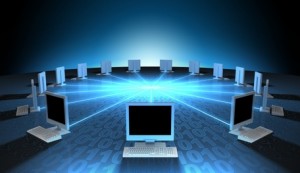Computers are devices that accomplish tasks or calculations in accordance to a set of directions, or programs. The first fully electronic computers, introduced in the 1940s, were voluminous devices that required teams of people to handle.In comparision to those new machines, today’s computers are astounding. They are not only thousands of times more expeditious, but also they can fit on your desk, on your lap, or even in your pocket. Computers are such an integral part of our everyday life now most people take them for granted.
Computers work through an interaction of hardware and software. The whole picture of the computer goes back to decades. However there are five apparent generations of computers. Each generation is defined by a paramount technological development that changes necessarily how computers operate – leading to more compressed, inexpensive, but more dynamic, efficient and booming machines.
First Generation – Vacuum Tubes (1940 – 1956)
These ancient computers utilized vacuum tubes as circuitry and magnetic drums for recollection. As a result they were huge, actually taking up entire rooms and costing resources to run. These were ineffective materials which produce a huge amount of heat, sucked enormous electricity and subsequently engendered an abundance of heat which caused perpetual breakdowns.
These first generation computers relied on ‘machine language’ (which is the most fundamental programming language that can be understood by computers). These computers were limited to solving one problem at a time. Input was predicated on punched cards and paper tape. Output emerged on print-outs. The two eminent machines of this era were the UNIVAC and ENIAC machines – the UNIVAC is the first ever commercial computer which was purchased in 1951 by a business named as the US Census Bureau.
Second Generation – Transistors (1956 – 1963)
The supersession of vacuum tubes by transistors, visualized the onset of the second generation of computing. Although first invented in 1947, transistors weren’t used considerably in computers until the cessation of the 1950s. They were a huge development over the vacuum tube, despite the fact still subjecting computers to destroying different levels of heat. However they were extremely superior to the vacuum tubes, making computers smaller, more expeditious, inexpensive and less burdensome on electricity use. They still count on punched card for input/printouts.
The language emerged from strange binary language to symbolic (‘assembly’) languages. This meant programmers could discover instructions in words. Meanwhile during the same time high caliber programming languages were being developed (early versions of COBOL and FORTRAN). Transistor-driven machines were the first computers to store instructions into their recollections, peregrinating from magnetic drum to magnetic core ‘technology’. The anticipatory versions of these machines were created for the atomic energy industry.
Third Generation – Integrated Circuits (1964 – 1971)
By this phase, transistors were now being miniaturised and put on silicon chips. This led to a huge improvement in speed and effectiveness of these machines. These were the first computers where users interacted utilizing keyboards and monitors which interfaced with an operating system, a consequential leap up from the punch cards and printouts. This facilitated these machines to run various applications at once utilizing a central program which functioned to monitor memory.
As a result of these advances which again made machines more reasonable and more tiny, a brand new group of users emerged during the ‘60s.
Fourth Generation – Microprocessors (1972 – 2010)
This innovation can be defined in one word: Intel. The chip-maker accomplished the Intel 4004 chip in 1971, which located all components of computer such as CPU, recollection, input/output controls onto a single chip. What overcrowded a room in the 1940s now gets fit in the palm of the hand.The Intel chip contained thousands of unified circuits. The year 1981 saw the first ever computer (IBM) categorically designed for home use and 1984 saw the Macintosh introduced by Apple. Microprocessors even transformed beyond the realm of computers and into an incrementing number of everyday products.
The incremented power of these small computers denoted they could be linked, establishing networks. Which eventually led to the expansion, birth and rapid evolution of the Internet. Other primary advances during this period have been the Graphical user interface (GUI), the mouse and more of late the startling advances in laptop capability and hand-held contrivances.
Fifth Generation – Artificial Intelligence (2010 Onwards)
Computer devices with artificial potentiality are still in development, but some of these technologies are commencing to emerge and be used such as voice recognition. AI is an authenticity, made possible by adopting parallel processing and superconductors. Inclining to the future, computers will be thoroughly revolutionized again by quantum computation, molecular and nano technology. The essence of fifth generation will be utilizing these technologies to ultimately engender machines which can proceed and acknowledge natural language, and have efficiency to determine and organise themselves.




Leave A Comment